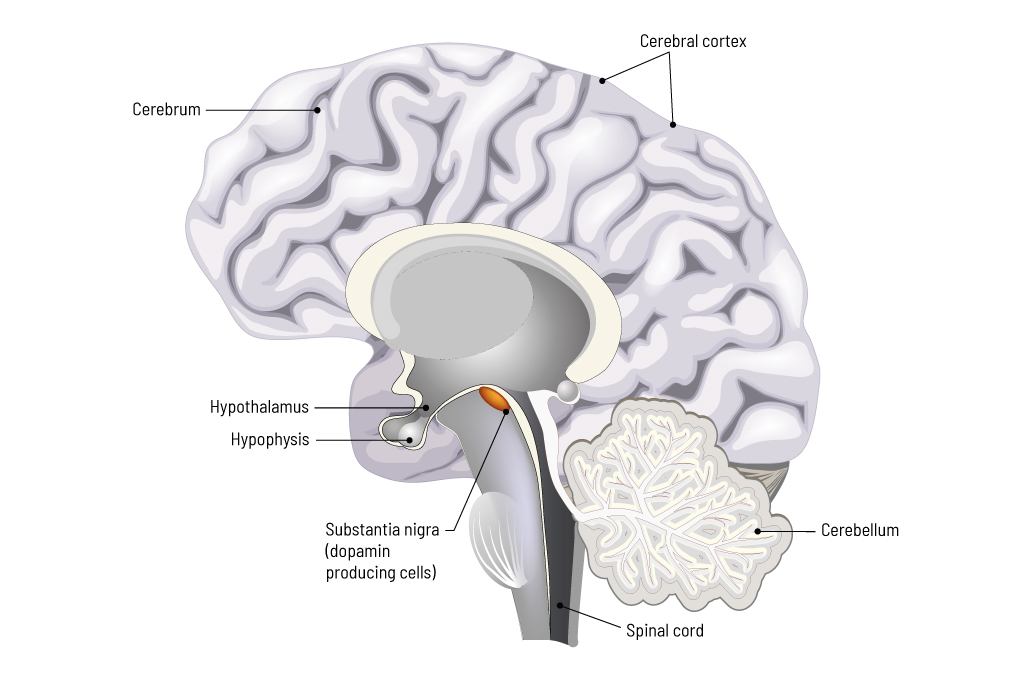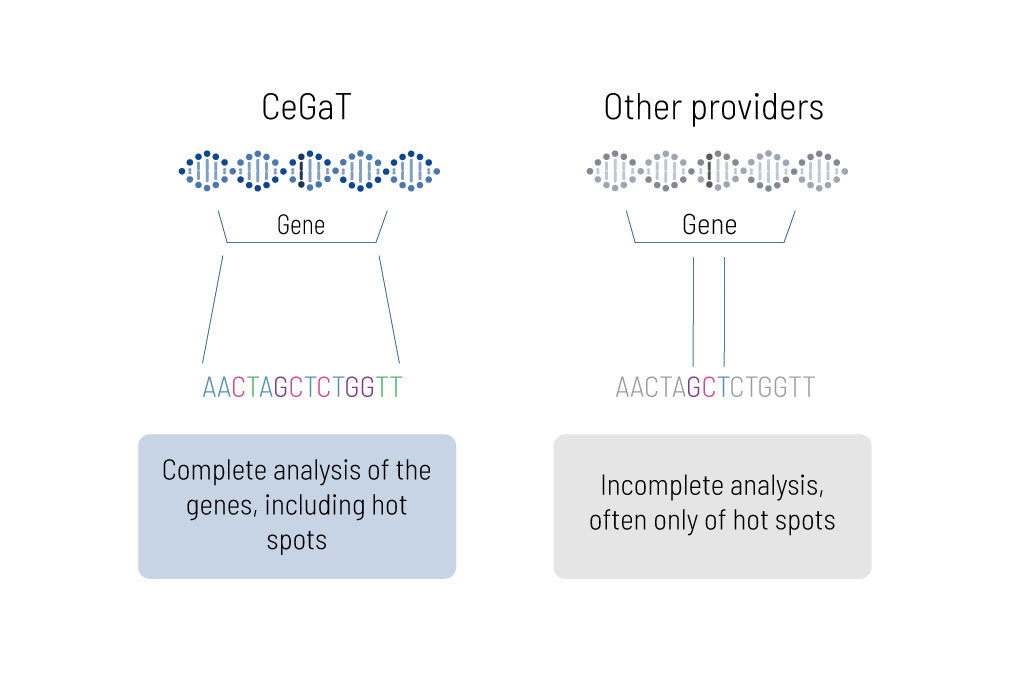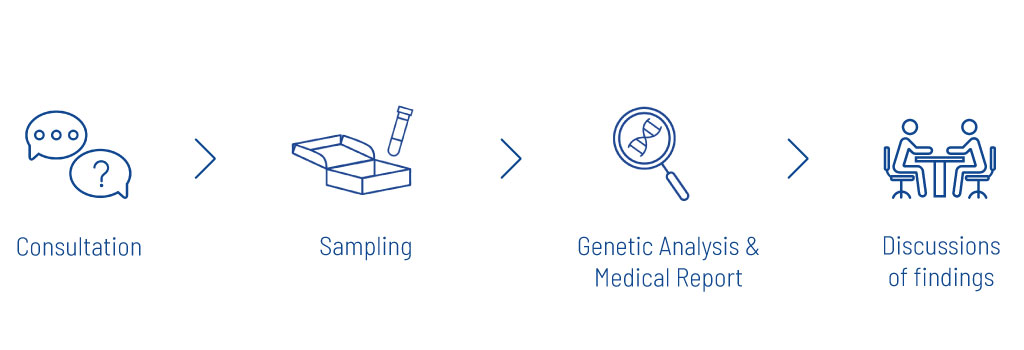Parkinson’s disease is the second most common neurodegenerative disease after dementia.1 Those affected are often between fifty-five and sixty years old at the time of diagnosis. However, some patients develop the disease at a younger age. A genetic analysis can provide clarity about the genetic risk of developing Parkinson’s disease. This means that you are prepared in the event of illness.
Are you insured in Germany? Our colleagues at Zentrum für Humangenetik Tübingen will gladly support you!
The Advantages of Our Predictive Analysis for Parkinson’s Disease
What is Parkinson’s Disease?
Parkinson’s disease is a neurodegenerative disease. It is caused by dying nerve cells in the midbrain, especially in a brain region named substantia nigra (figure 1). The nerve cells (neurons) in this region are responsible for producing the neurotransmitter (messenger substance) dopamine.
Dopamine is essential for the communication between nerve cells and, therefore, for the fine adjustment of movement sequences. In Parkinson’s disease, there is an increased death of these dopamine-producing cells. As a result, movements can no longer be carried out correctly, and typical symptoms such as slow movement, stiffness, or tremors can occur. The disease can have various causes, whereby genetic variants can also play a role.
A neurotransmitter is a biochemical messenger that carries information between nerve cells (neurons) or, e.g., from nerve cell to muscle. Different types of neurotransmitters have different effects on the recipient cell. A distinction is made between inhibitory and excitatory signals.
The neurotransmitters are kept in vesicles (small bubbles) in the preceding nerve cell (presynapse). If a signal arrives at the end of a nerve cell, neurotransmitters are released into the synaptic cleft, the intermediate space to the next cell. Upon reaching the subsequent cell, the neurotransmitter binds to specific receptors and thereby transmits the signal to this cell (figure 2).
Dopamine is of great relevance to Parkinson’s disease. It has an activating effect and ensures that movement sequences can take place in a coordinated manner. However, in the presence of Parkinson’s disease, not enough dopamine is present in the brain. The lack of dopamine inhibits the respective signal transduction, leading to impaired movement sequences and, therefore, impaired mobility (figure 2).
The causes of the development of Parkinson’s disease have not yet been finally clarified. Genetic factors as well as environmental factors, and a combination of these can cause the death of dopaminergic neurons. The lack of dopamine ultimately leads to the described limitations.
If an increased risk of Parkinson’s disease is identified, it is possible to react at an early stage and, if necessary, counteract with medication.
Four Reasons for CeGaT’s Predictive Analysis for Parkinson’s Disease

Certified Laboratory
All samples are processed in-house. CeGaT’s laboratory is accredited according to CAP/CLIA and DIN EN ISO 15189 and ensures reliable results.

Long-Term Expertise
Since fifteen years we are your experts for genetic diagnostics. Thanks to our many years of experience, you can rely on our knowledge and the quality of our work.

Risk Genes in Focus
We only examine relevant genes that have been scientifically confirmed as risk genes and pose a risk of disease. You can find out which genes are examined here.
Comprehensive Analysis of Genes
Using next-generation sequencing, we analyze the sequences of the selected genes in their entirety and do not limit ourselves to so-called hotspot regions. This ensures that no relevant information is overlooked and provides you with reliable findings.
Field Report
Felix H., 30 years old
Lifestyle: sporty and adventurous
Result: for Felix H., our predictive diagnostics found an increased risk for Parkinson’s disease due to a variant in the gene PARK7, that can trigger an onset of Parkinson’s disease before the age of fourty.
Consequence: Felix H. regularly visits the doctor, to be able to take countermeasures at an early stage if necessary.
„The analysis of my genes has given me clarity about my genetic predisposition and sensitized me to the early detection of a possible disease. This makes me feel better prepared for the future.”
How Does Genetic Risk Assessment Work?
Various factors contribute to the development of Parkinson’s disease. We help you to determine the genetic risk factors. In the predictive Parkinson’s disease analysis, seventeen genes are analyzed that are associated with an increased risk for Parkinson’s disease.
Our Expert
General Information
Genetic Counseling
Our genetic counseling provides detailed information to those seeking advice about their genetic testing options and further procedures. During the consultation, we also discuss which genes can be analyzed. We want to ensure that all relevant questions are answered and that people seeking advice can make informed decisions about their health.
Genetic Analysis and Result
Our in-house laboratory analyzes the genes using an advanced technology called next-generation sequencing, or NGS for short. To do this, we isolate the DNA from the cells in the blood sample (figure 4) and then read the individual building plan of the DNA step by step (sequencing). We do not limit ourselves to so-called hotspot regions. Instead, we read the genes in their entirety.
The sequenced information is then analyzed in-house. We investigate whether particular characteristics or changes (variants) in the genes are associated with an increased risk of disease. We compile the results in a report and conclude by explaining what significance this could have for the health of the person seeking advice.
Further details on sample material and shipment can be found here.
Frequently Asked Questions
Before Choosing a Test
Sample & Analysis
Result & Consultation
Storage and Data Protection
Predictive Healthcare for Companies
Companies and healthcare facilities rely on our many years of experience and expertise in genetic diagnostics.
Are you also interested in predictive healthcare for your employees?
Downloads
Contact Us
Do you have a question, or are you interested in our service?
Diagnostic Support
We will assist you in selecting the diagnostic strategy – whether as a person seeking advice or as a physician.

References
1 GBD 2017 Disease and Injury Incidence and Prevalence Collaborators. Global, regional, and national incidence, prevalence, and years lived with disability for 354 diseases and injuries for 195 countries and territories, 1990-2017: a systematic analysis for the Global Burden of Disease Study 2017. Lancet. 2018 Nov 10;392(10159):1789-1858. doi: 10.1016/S0140-6736(18)32279-7. Epub 2018 Nov 8. Erratum in: Lancet. 2019 Jun 22;393(10190):e44. PMID: 30496104; PMCID: PMC6227754.









